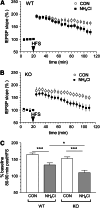Histamine receptor expression, hippocampal plasticity and ammonia in histidine decarboxylase knockout mice
- PMID: 21710252
- PMCID: PMC11498542
- DOI: 10.1007/s10571-011-9730-1
Histamine receptor expression, hippocampal plasticity and ammonia in histidine decarboxylase knockout mice
Abstract
Genetic ablation of the histamine producing enzyme histidine decarboxylase (HDC) leads to alteration in exploratory behaviour and hippocampus-dependent learning. We investigated how brain histamine deficiency in HDC knockout mice (HDC KO) affects hippocampal excitability, synaptic plasticity, and the expression of histamine receptors. No significant alterations in: basal synaptic transmission, long-term potentiation (LTP) in the Schaffer collateral synapses, histamine-induced transient changes in the CA1 pyramidal cell excitability, and the expression of H1 and H2 receptor mRNAs were found in hippocampal slices from HDC KO mice. However, when compared to WT mice, HDC KO mice demonstrated: 1. a stronger enhancement of LTP by histamine, 2. a stronger impairment of LTP by ammonia, 3. no long-lasting potentiation of population spikes by histamine, 4. a decreased expression of H3 receptor mRNA, and 5. less potentiation of population spikes by H3 receptor agonism. Parallel measurements in the hypothalamic tuberomamillary nucleus, the origin of neuronal histamine, demonstrated an increased expression of H3 receptors in HDC KO mice without any changes in the spontaneous firing of "histaminergic" neurons without histamine and their responses to the H3 receptor agonist (R)-α-methylhistamine. We conclude that the absence of neuronal histamine results in subtle changes in hippocampal synaptic transmission and plasticity associated with alteration in the expression of H3 receptors.
Figures







References
-
- Adachi N (2005) Cerebral ischemia and brain histamine. Brain Res Brain Res Rev 50:275–286 - PubMed
-
- Alves-Rodrigues A, Timmerman H, Willems E, Lemstra S, Zuiderveld OP, Leurs R (1998) Pharmacological characterisation of the histamine H3 receptor in the rat hippocampus. Brain Res 788:179–186 - PubMed
-
- Arrang JM, Morisset S, Gbahou F (2007) Constitutive activity of the histamine H3 receptor. Trends Pharmacol Sci 28:350–357 - PubMed
Publication types
MeSH terms
Substances
LinkOut - more resources
Full Text Sources
Research Materials
Miscellaneous

